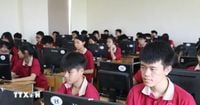In a significant shift for university admissions in Vietnam, the Ministry of Education and Training has announced new regulations that will take effect starting with the 2025 academic year. This change allows universities and colleges to expand their admission combinations, moving away from the previous restriction of a maximum of four combinations based on high school graduation exam scores for each major.
Beginning in 2025, students will first sit for the high school graduation exam under the new 2018 general education program. This exam will require students to take two compulsory subjects, Math and Literature, alongside two optional subjects selected from a list of nine options, including Foreign Language, History, Physics, Chemistry, Biology, Geography, Economic and Legal Education, Informatics, and Technology. This setup will create a total of 36 possible combinations for university admissions.
Among the new subjects entering the admissions combinations for the first time are Economic and Legal Education, Informatics, and Technology. According to representatives from various higher education institutions, these changes are aimed at increasing opportunities for students, ensuring equity among candidates from different regions.
For instance, Hanoi University of Science and Technology has announced the addition of two new admission combinations: K01, which includes Math and Literature along with one of four subjects (Physics, Chemistry, Biology, Informatics), and D04, which incorporates Math, Literature, and Chinese. Similarly, the University of Technology (Vietnam National University, Hanoi) plans to introduce two combinations: Math, English, Informatics and Math, Physics, Informatics.
Hanoi University of Industry is also expanding its offerings with five new combinations that feature Technology, Informatics, and Economic and Legal Education, such as A0C (Math, Physics, Technology) and D0G (Math, English, Economic and Legal Education). The University of Transport has added a new combination, GT1 (Math, Physics, Informatics), for various programs including Computer Science and Information Technology.
However, the introduction of these new combinations has raised concerns among educators and the public regarding their relevance to the respective fields of study. For example, some institutions are reportedly offering admission combinations for Physics Education with only one combination that includes Physics, while others have combinations for History Education that do not include History at all. This trend has prompted worries about the quality of education and the suitability of students for their chosen majors.
Nguyen Anh Dung, Deputy Head of the Higher Education Department at the Ministry, emphasized that while the number of admission combinations is no longer limited, it is essential to maintain quality and ensure that students possess the necessary foundational knowledge for higher education. The new regulations stipulate that combinations must include at least three subjects, with Math or Literature contributing no less than 25% of the total score. By 2026, the common subjects in the combinations must account for at least 50% of the total score.
In addition to these changes, the new enrollment regulations eliminate the practice of early admissions. Pham Thai Son, Director of the Admissions and Communications Center at Ho Chi Minh City University of Industry, explained that the previous system of early admissions led to prolonged enrollment periods and unnecessary resource expenditure, as candidates had to confirm their academic results and apply to multiple institutions.
Under the revised guidelines, universities will have to use the entire 12th-grade academic record for transcript evaluations, with a weight of no less than 25%. This means that students must perform well throughout their final year, rather than relying solely on early exam scores.
The new rules also require universities to establish fair conversion methods for different admission pathways and combinations, ensuring that all candidates have equal opportunities. This includes standardizing the scoring system across various admissions methods and ensuring that any bonus points or incentives do not disproportionately favor certain candidates.
Nguyen Trung Nhan, Head of the Training Department at Ho Chi Minh City University of Industry, noted that universities are currently working on developing a common scoring scale, typically a maximum of 30 points, to facilitate fair comparisons among candidates.
Despite these changes, there are still concerns about the clarity of the regulations regarding the prioritization of students with exceptional achievements or foreign language certificates. Some institutions have expressed the need for clearer guidelines to ensure that talented students are not disadvantaged in the new system.
As the 2025 high school graduation exam approaches, scheduled for June 26 and 27, the education sector is poised for a transformative year. With these new regulations, the Ministry of Education and Training aims to enhance the fairness and transparency of the admissions process while providing students with a broader range of choices in their educational paths.
In conclusion, the adjustments in Vietnam's university admissions process reflect a commitment to modernizing education and adapting to the evolving needs of students. As the landscape of higher education continues to change, these reforms will play a crucial role in shaping the future of academic opportunities for young people across the country.





